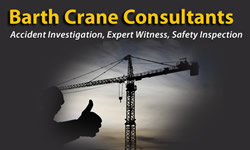articles
Tower Cranes Warrant Closer Look
As originally published by Safety Solutions, March 2008.
By: Thomas Barth
Tel: 843-871-8877
Email Mr. Barth
View Profile on Experts.com.
According to statistics, about 125,000 tower cranes are operating worldwide and, on average, are erected in 2 days on various jobsites to build skyscrapers. There are two types of cranes, tower and mobile, which can be purchased or rented depending on the company's scope of work. Mobile cranes are limited because they must be moved from location to location on the jobsite to maneuver materials. Tower cran es can be placed closer toge ther, have a radius of about 140 square meters, and can lift steel, concrete, and a va riable range of building material. Contractors can save 50 percent on the cost of material handling by using self-erecting tower cranes and onsite labor, saving thousands. Due to the flexibility of tower cranes, they are becoming more commercialized and are high in demand.
CRANE OPERATION
Operating a crane is very demanding and requires the operator to stay focused. Because the crane is usually the tallest piece of equipment on the jobs ite, the base of the crane is typically bolted onto a large concrete pad. The base connects to the mast, which holds the gears and motor at the top, allowing the crane to rotate.
CRANE SAFETY
Crane safety comes under scrutiny when there is an accident. Some of the disturbing findings include operators unknowingly using defective cranes, maintenance personnel not trained to recognize defects, and no plan in place to prevent cranes from colliding when two or more are present on the jobsite. There should be no slippage of training or inspection. Upon investigation, most accidents lead primarily back to these areas.
PROPER OPERATION
Thomas Barth has a foundation of 38 years as a Crane Operator, Crane Inspector, and Crane Operator Trainer. Mr. Barth has proven his professionalism as an expert witness in Crane Accident Investigations across the country. His career-long commitment to crane safety has led him to carefully study the industry's practices, procedures, and equipment. He has investigated more than 83 crane accidents including several high-profile accidents.
©Copyright - All Rights Reserved
DO NOT REPRODUCE WITHOUT WRITTEN PERMISSION BY AUTHOR.


